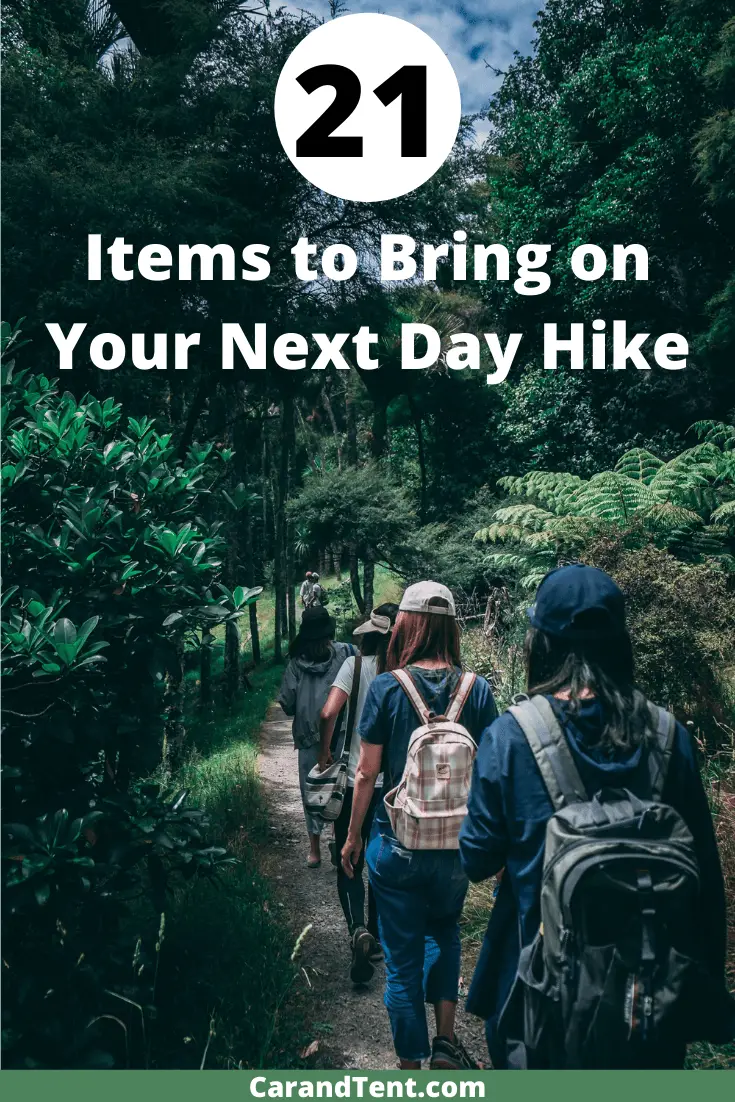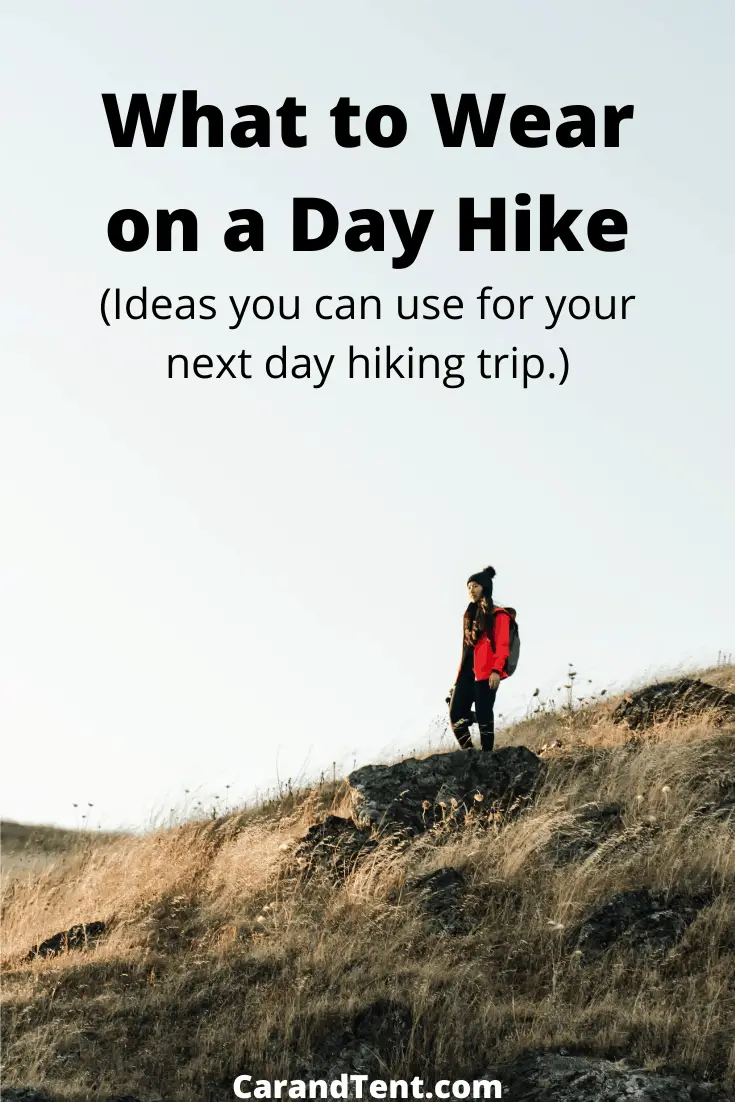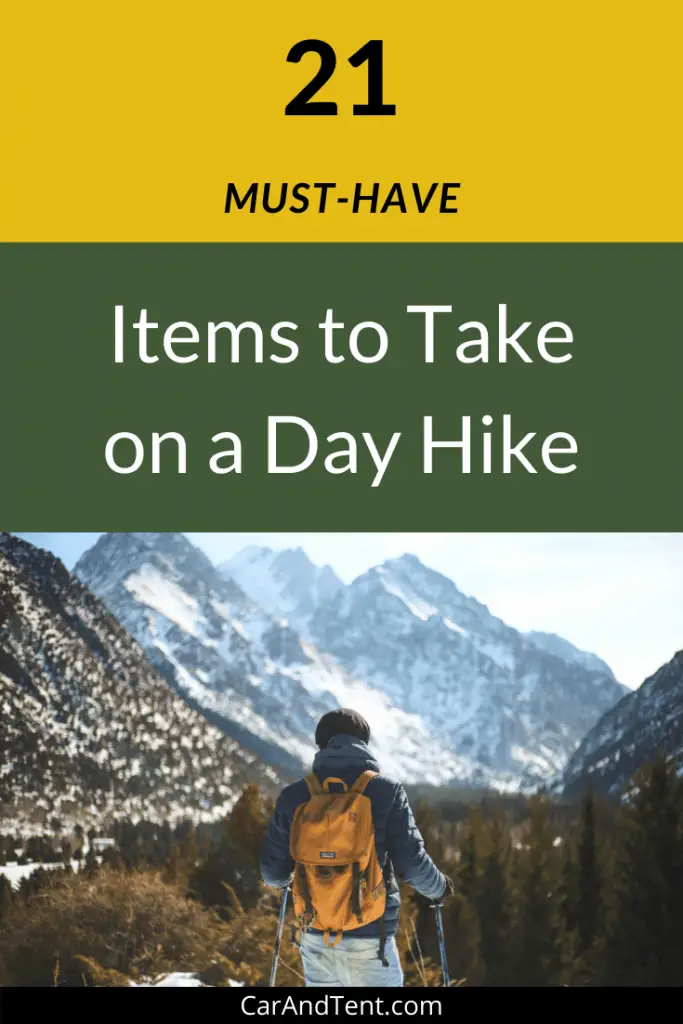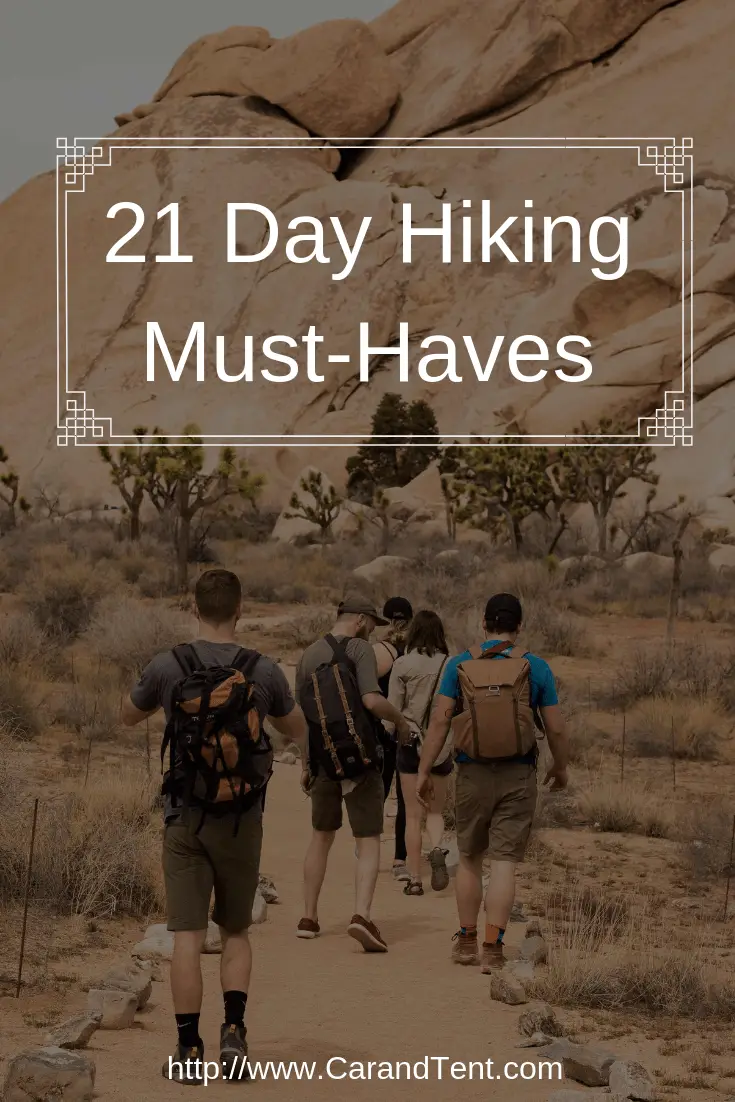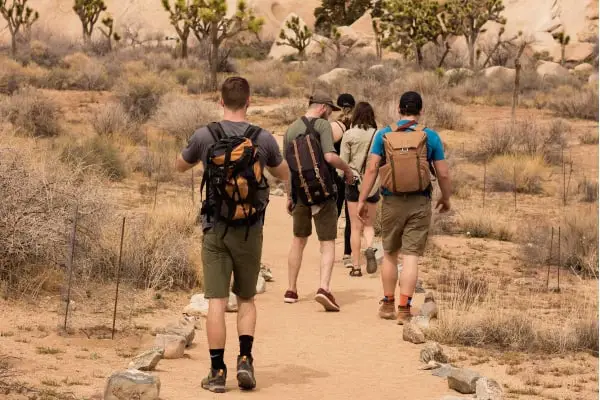
Day hikes aren’t all that complicated but there are a couple of things you should know before heading out. Two of the most important things to know are what to wear and what to bring with you on your hike.
In this post, I’ll tell you exactly what to wear and what to bring on a day hike so you can have a fun and safe time out on the trails.
Table of Contents
Footwear that Matches the Terrain You’ll Be Hiking In
Hiking boots are fantastic and I have a lightweight and breathable pair that I wear all year long. This being said, hiking boots aren’t the only option. For those of you who will be hiking through areas without many snakes, a good pair of trail runners will work just as well as boots and they’ll be lighter on your feet.
For those of you who are hiking through streams and muddy terrain, you might want to bring a pair of aquatic hiking shoes. These shoes will dry out quickly and cleaning them off at home is as simple as spraying them down with your hose.
Clothing that Matches the Climate You’ll Be Hiking In
There really isn’t one perfect pair of hiking pants or one shirt that can be used in all situations. In warmer weather, you’ll want to wear lighter clothing and in colder weather, you’ll want to wear thicker clothing.
Ideally, you’ll dress in layers and you’ll bring long pants and long sleeve shirts made from materials that wick moisture away from your body. This way, you can shed clothing when necessary and you won’t have to worry as much about sweat being trapped against your body.
In the summer, I’ll often wear a pair of zip-away hiking pants. When the weather gets colder, I’ll wear a thicker pair of hiking pants and a thermal layer underneath.
For my upper body, I’ll stick to a tee-shirt on completely wooded trails but will wear a lightweight long-sleeve button-down shirt in areas where I know I’ll be exposed to the sun. In the winter, I’ll add as many layers as I think I’ll need and often find that I end up taking one or two off during my hike. Because of this, I like to make sure most of the outer layers have zippers so they’re easier and quicker to take off.
A Wide-Brimmed Hat and Sunglasses
Prolonged exposure to the sun doesn’t just cause cancer and premature aging. A bad burn can cause immediate and life-threatening damage to your body. If you’re three hours out on a desert trail, you don’t want to be suffering from a bad burn.
Protect yourself with a wide-brimmed hat and a pair of polarized sunglasses. Not only will you live longer and look better, but you’ll have a more pleasant hike when you’re not suffering from sunburn.
8 – 16 Ounces of Water Per Hour of Hiking
Whether you’re hiking in warm weather or cold weather, you’ll need to drink water. Most medical experts recommend that you drink about 8 ounces of water an hour so you’ll want to bring that amount at a minimum.
This being said, you’ll probably break a sweat while out on the trail so it’s a good idea to bring some extra water with you. I generally like to bring a 16-ounce bottle of water for every hour that I intend on hiking. If I’ll be out on the trail for the entire day, I might switch over to a hydration bladder to make carrying the water easier.

Your Cell Phone
The cell phone is a modern-day marvel. It’s a way to call for help, it’s a way to look up directions, it’s a way to quickly access all of human knowledge, and you can even use it as a compass. Charge it to 100% and take it with you on your hike.
Even if you’ll be in an area without service, your cell phone could still end up saving your life. This is because if you go missing, emergency personnel can use it to determine your last known location.
Your Wallet
You probably won’t find any ATMs out on the trails but you might need them when you come off the trail. Imagine, you’ve gotten turned around and you’ve come out of the trail at a different trailhead than where you parked. Wouldn’t it be nice to have your credit cards and some cash to help you get back to the right trailhead?
Additionally, your wallet will have your identification on you. Fall and hit your head on the trail and emergency responders will know who you are when somebody finds you.
A Trail Map – (When Available)
If at all possible, grab a trail map before you head out. Some trails will have these posted up at the beginning of the trail and some will not.
If there aren’t any trail maps available, take a picture with your phone of the large one posted at the beginning of the trailhead. When this isn’t available, do a quick Internet search and see if you can find one online. Download it to your phone in case you need it later when you’re out of cell phone range.
A Daypack
I’ll be suggesting that you take along a lot of other gear with you on your trip so you’ll want to have a nice daypack to carry it all with you. My go-to daypack is my Lowepro Photo Hatchback but you can choose anything that fits well, is comfortable, and has enough room to carry all of the gear I’ll be recommending below.
Why so much gear for just a day hike?
The reason I recommend bringing a lot of gear even when you’re only going for a day hike is that you never know when a day hike could turn into more than just a day hike. During a simple 2-hour hike, you could become trapped by a natural disaster, you could become lost, or you could even injure yourself to the point that you can’t immediately hike back out. Bring the rest of the gear on this page and you’ll dramatically increase the chances that you survive these situations.
Extra Clothing
Extra clothing is useful in both winter and summer hiking situations. In the winter it’s nice to be able to add layers and in the summer it’s nice to be able to put on dry clothes. This is especially true when hiking through wet terrain.
The extra clothes aren’t just for times when you might get stranded on the trail either. Just being able to change into dry socks midway through a hike can make the hike a lot more enjoyable.
High-Energy Hiking Food
You’ll burn a lot of energy when hiking. For some people, this might be the desired effect. For other people, losing weight while hiking is an unwanted side-effect. Either way, you’ll want to bring some extra food in case you need it. You’ll be especially grateful for it should you become stranded or even if you just decide to spend a few extra hours on the trials.
Bring high-energy foods that are easy to carry. Good examples of these are trail mix, peanuts, and energy bars. Oftentimes I’ll pack a sandwich with me inside of a small sandwich container. If it’s cold out I’ll pack something with meat on it and if it’s hot out I’ll opt for a Pb&J.
Bug Spray
It might be a hassle to have to put bug spray on, but it is less of a hassle than pulling ticks off of your body. On the trail, you can expect to find ticks, mosquitos, flies, and a whole other host of bugs and insects that want to eat you.
Many people keep these pests off by using permethrin on their clothing and a DEET-based spray on their skin. The permethrin is used to kill insects and the DEET is used to camouflage the skin so that you won’t be bitten.
Are these bug sprays bad for your health?
DEET has been around since 1946 so there has been a lot of time to study its effects. The EPA has done extensive testing on it and they found that DEET is safe for both adults and children to use. Permethrin has been examined by both the EPA and the FDA. Both organizations agree that it is toxic but safe to use on humans as long as it is not eaten.
Personally, I only use DEET. DEET doesn’t kill bugs and insects and it is safe to use on humans and around pets.
Permethrin, on the other hand, will kill bugs and insects. This might seem great on the surface but not all bugs are bad and I don’t want to harm wildlife that is not a threat to me. Also, permethrin can be especially harmful to birds and fish as well so it isn’t exactly great for the environment.
Bear Spray
A can of bear spray is a must-have item when hiking through bear country. I’d also recommend you bring it while hiking on trails that aren’t known for bears as well.
Bear spray can help you defend yourself against animals other than bears. Mountain lions, wolves, stray dogs, and even humans can all be deterred through the proper use of bear spray.
For more details on how to stay safe from bears, check out the post titled, “Camping with Bears – How to Stay Safe“.

Sunscreen and Lip Balm
I won’t harp on this too much as we all know that we should wear sunscreen and lip balm to protect against the sun. Getting a bad burn while out on the trail will make the hike much less pleasant and will lead to both short and long-term health problems.
Apply the sunscreen and lip balm before you head out to the trails and bring some with you so that you can reapply it every 3 – 4 hours. Even if you only plan on doing a 2-hour hike, bring it anyway. You never know when you might decide to put in a few extra hours.
A First-Aid Kit
A basic first aid kit could save your life or the life of someone else while out on the trail. Any basic first-aid kit should do for most people. Just choose one with a good supply of gauze, bandages, band-aids, wraps, and antibiotic ointment and you should have all the basics covered.
Even if you never experience a life-threatening event, it is nice to be able to have bandaids and antibiotic creams to help protect the small cuts you might get while scrambling or working with sharp gear. I also add some OTC pain relievers and anti-itch cream and I’ve found them to be useful on many occasions.
An Emergency Blanket
Emergency blankets are small enough to fit in your pocket and can be used in a multitude of ways. They’ll help you keep warm, provide overhead protection from the rain, catch rainwater for drinking, and can even be used to help signal rescue personnel.
These blankets are made from mylar so they hold up well even in humid conditions, (like your pocket). I buy these blankets in bulk and keep them in my car, my backpacks, and even at the office.
A Poncho
Wet-weather gear is always best when hiking in the rain, but a poncho is easier to pack and will provide you with a lot of protection against the rain. Buy a cheap throw-away poncho that you can leave in your day-pack and you’ll never be without protection from the rain.
Like the emergency blanket, a poncho can have many different purposes. Even if you live in an area that rarely ever gets any rain, you’ll still be better off having one with you.
Prescription Medicines
Anyone who relies on daily medications should always bring some extra medicine with them while day hiking. Again, your day hike could quickly turn into a multi-day hike and you just might need to have some extra medicine on you to survive the ordeal.
Headlamp or Flashlight
A headlamp or flashlight will help you find your way back on those hikes that last just a little longer than you expected. They’ll also help you should you get stranded overnight.
Even if neither of these events occurs, you still may find yourself in need of a flashlight while out on the trail. For example, your hiking trail might pass by an interesting rock crevice or cave. Wouldn’t it be nice to have a flashlight so that you could get a better look?
A Field Guide
Field guides are useful for all kinds of reasons. You can buy field guides that teach you emergency first-aid, field guides that tell you what wild edibles can be eaten in your area, and even field guides to tell you about the wildlife in your area.
For safety purposes, wilderness first-aid field guides are critical. Add one of these guides to your day pack and bring along any other field guides you feel could be of use to you.
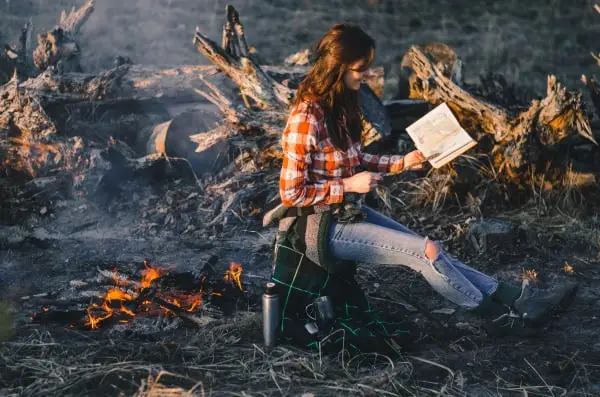
A Knife
A sturdy knife can help you in all sorts of situations. Use it to help you build a fire, use it to open your pre-packaged food, or to cut items in your first-aid kit.
The knife doesn’t have to be very large either. A small 2.5-inch blade knife will be easier to carry and easier to use than the one Rambo carries. Also, a knife this small will be less frowned upon by local law enforcement should you be pulled over on your way to the trail.
A Heat Source
If you’ll be hiking through an area with ample materials that can be used to build a fire, just bring a lighter or some waterproof matches. Having these items will help you quickly build a fire in case of an emergency.
For other areas, you might want to consider bringing a small alcohol stove. A stove like this is lightweight, inexpensive, and easy to pack.
Final Thoughts
You may have looked at this list and thought to yourself, why do I need all of this just for a day hike? The reason is that one wrong turn, one slip-and-fall, or one natural disaster can quickly turn a day hike into an overnight one. If you’ve taken everything I’ve suggested with you on your day hike, you’ll be better prepared to deal with any emergencies that might arise.
